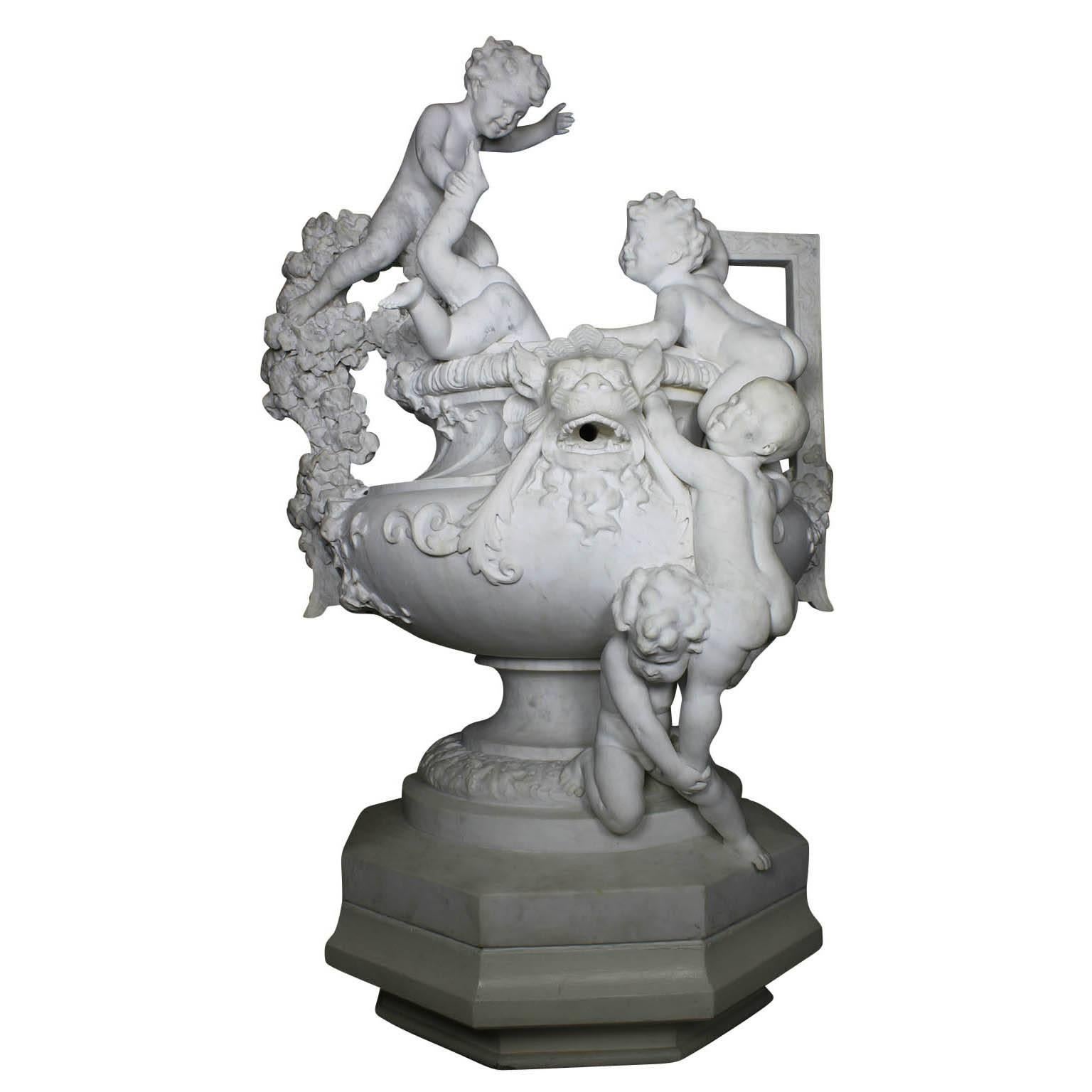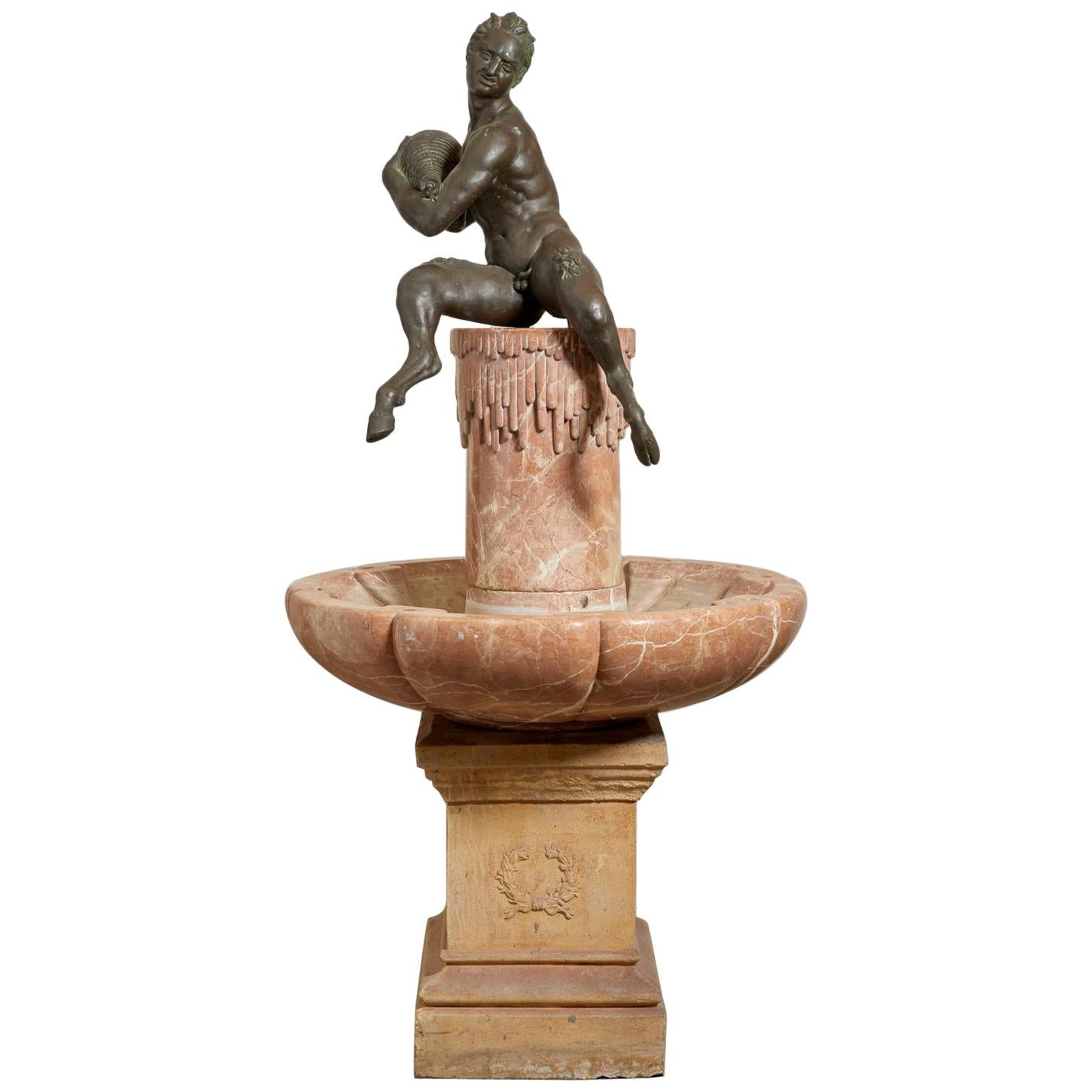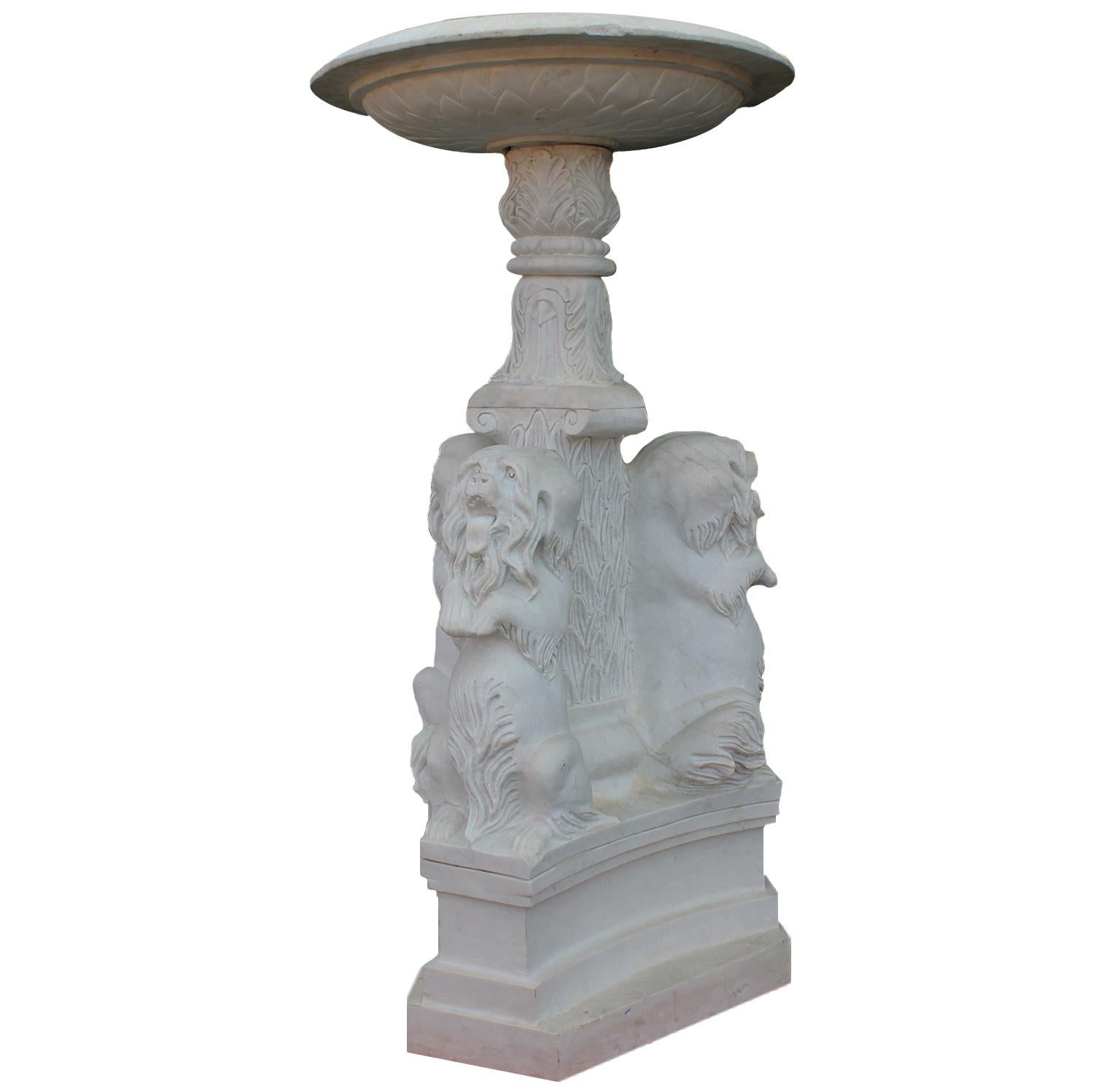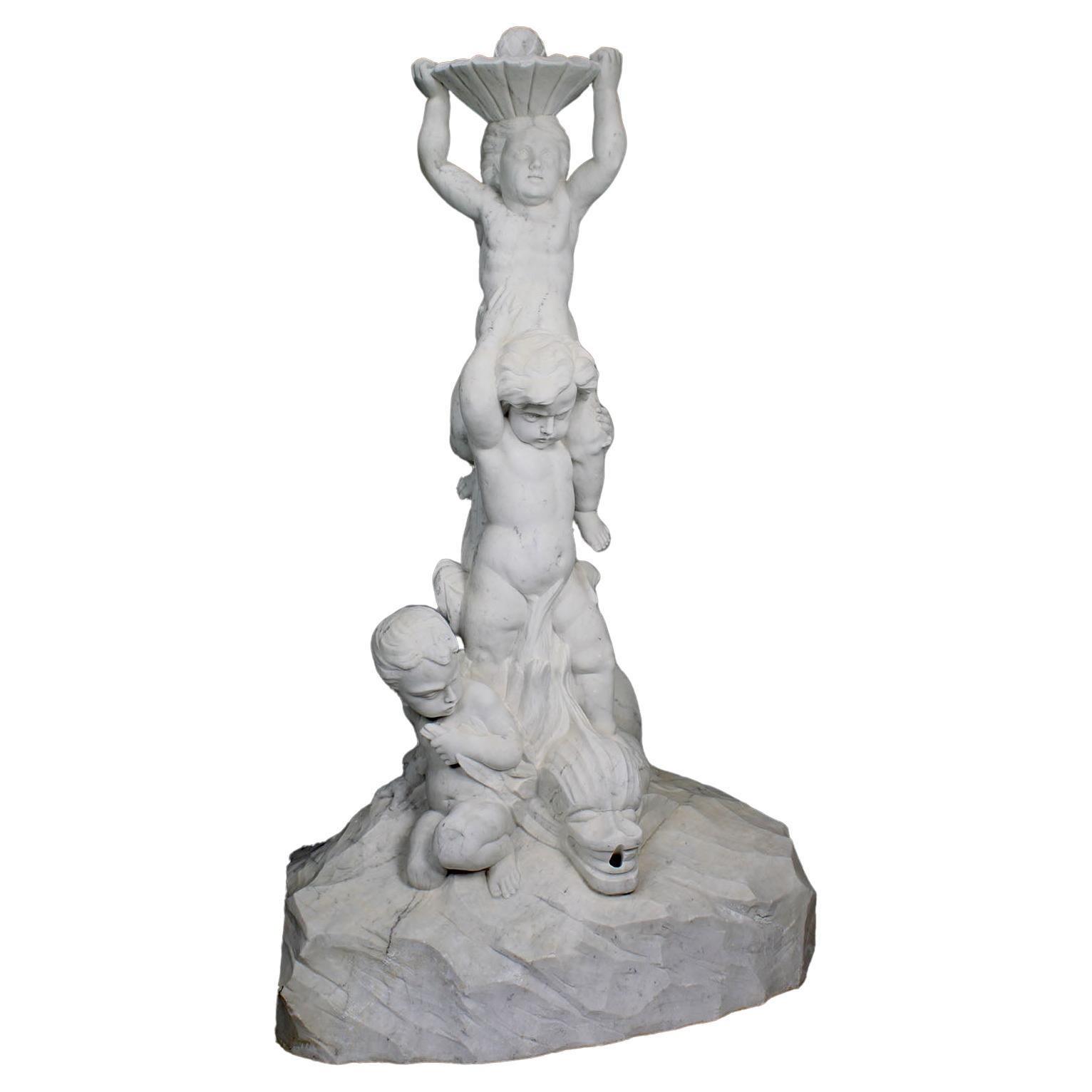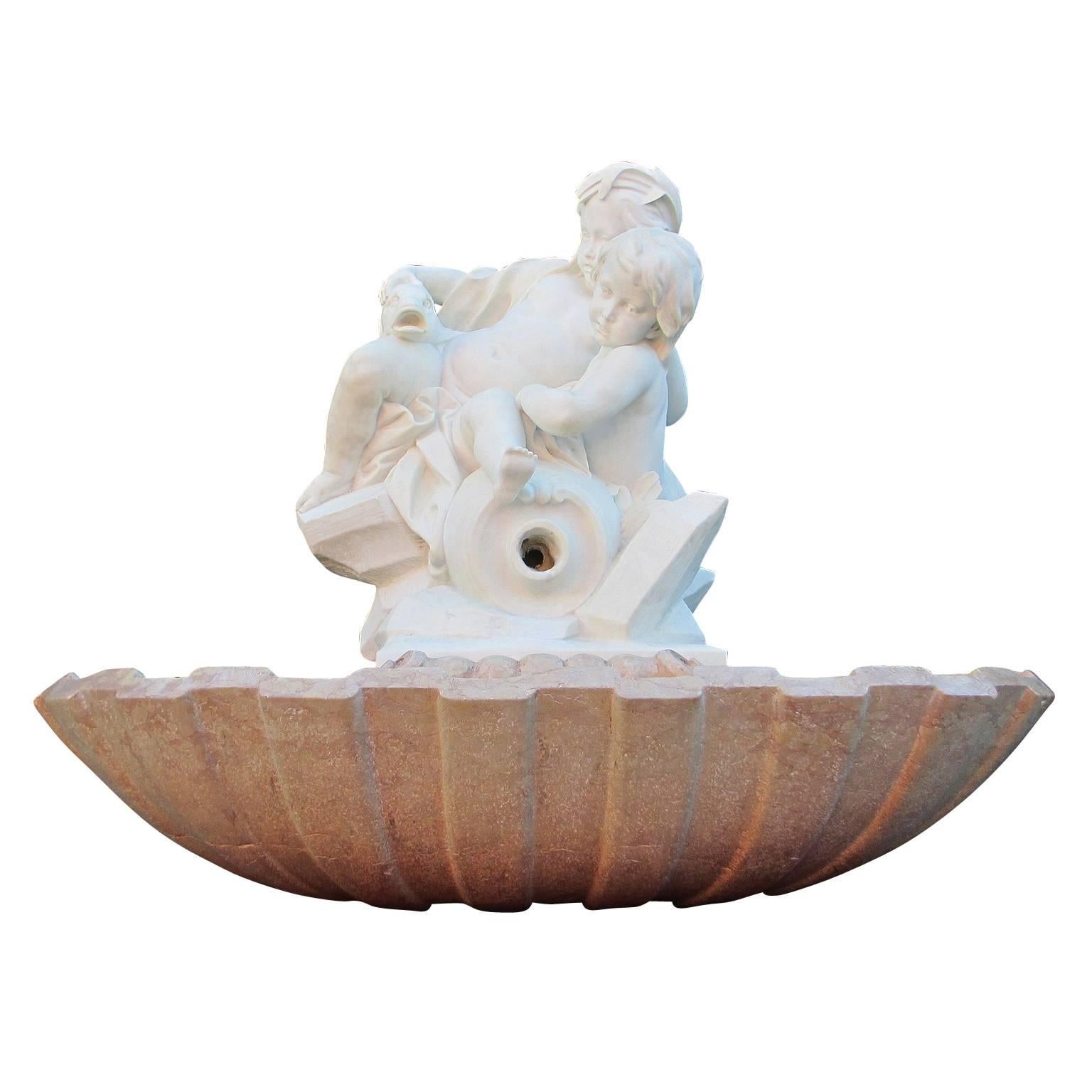Items Similar to A French 19th-20th Century Carved White Marble Fountain Sculpture with Children
Want more images or videos?
Request additional images or videos from the seller
1 of 6
A French 19th-20th Century Carved White Marble Fountain Sculpture with Children
About the Item
A fine and charming French 19th-20th century carved white marble whimsical group sculpture depicting two putti (Children) playing with a dolphin, fitted for use as a fountain, Paris, circa 1900.
Measures: Height 36 1/4 inches (92.1 cm)
width 21 1/4 inches (54 cm)
depth 18 inches (45.7 cm).
- Dimensions:Height: 36.25 in (92.08 cm)Width: 21.25 in (53.98 cm)Depth: 18 in (45.72 cm)
- Style:Louis XV (In the Style Of)
- Materials and Techniques:
- Place of Origin:
- Period:1900-1909
- Date of Manufacture:circa 1900
- Condition:Wear consistent with age and use. Minor losses. Minor fading. A beautiful sculpture, fitted with a copper water pipe inside the dolphin's mount for use as a fountain. It has some weathering and discoloration at the base, by the Putti's feet. Some nicks and minor age losses.
- Seller Location:Los Angeles, CA
- Reference Number:
About the Seller
5.0
Vetted Seller
These experienced sellers undergo a comprehensive evaluation by our team of in-house experts.
Established in 1982
1stDibs seller since 2016
113 sales on 1stDibs
Typical response time: <1 hour
- ShippingRetrieving quote...Ships From: Los Angeles, CA
- Return PolicyThis item cannot be returned.
More From This SellerView All
- French 19th Century Carved Marble Whimsical Figural Urn Fountain with ChildrenBy Joseph Reynés I GurguiLocated in Los Angeles, CAA very fine large, rare and charming, French, 19th century. Belle Époque carved white marble whimsical figural urn fountain depicting children climbing on an urn with flowers and garlands, influenced in the Louis XV style, by Joseph Reynés I Gurgui (Barcelona, 1850-1926). Signed: Reynes. Barcelona, circa 1890. An almost identical Carrara marble fountain also by Josep Reynés carved in 1893 currently at the Parc de la Ciutadella in Barcelona, Spain. Measures: Overall height: 55 inches (140 cm) Marble height: 49 inches (124.5 cm) width: 37 inches (94 cm) depth: 30 inches (76.3 cm) Joseph Reynes Gurguí (Barcelona, 1850 - 1926) is a Catalan sculptor, also known as Reynesy-Gurgui, Spanish school. He studied at the Ecole de la Llotja, studied for a time in Paris, in the workshops of the great French sculptors Jean-Baptiste Carpeaux (1827-1875) and Carrier-Belleuse (1824-1887). He devoted himself mainly to interior decoration. His works were profoundly marked by a French influence. He exhibited in Paris in 1895 where he received an honorable mention. In 1890 he obtained the first medal in Madrid for "The Violinist". Literature: E. Benezit Dictionaire des Peintres, Sculpteurs, Dessinateurs et Graveurs by Grund - Nouvelle Edition, 1976 - Volume 8, Page 714. Cristina Mensoza, Ramon Casas...Category
Antique 19th Century Spanish Louis XV Fountains
MaterialsMarble
- Italian 19th-20th Century Whimsical White Marble Wishing Wellhead with ChildrenLocated in Los Angeles, CAA very fine and exceptionally carved Italian 19th-20th century Baroque Revival style whimsical white Carrara marble wishing wellhead, raised on an octagonal two-step marble base. The intricately carved marble relief circular wellhead depicting carved figures of dancing and cheerful children (Putti) among vines, flowers and fruits, dancing and playing musical instruments with a backdrop of castles, landscapes, forests and wreaths, Florence, circa, 1900. Literature: A similar wellhead was sold by Jan's & Co. Fine French Antiques, Inc. in 1999, provenance the Atkinson/Kirkeby Estate and it is illustrated in "The Estates of Beverly Hills" by Charles Lockwood and Jeff-Hyland, page 150. Another similar is currently on display at the gardens of "The Elms" mansion a public museum part of the Newport Mansions by The Preservation Society of Newport County in Newport, Rhode Island. Yet another similar wellhead carved with frolicking putti with musical instruments and a dentil molded rim is located at Cranbrook House, Bloomfield Hills, Michigan, and is illustrated in B. Israel, Antique Garden Ornament...Category
Antique Early 1900s Italian Baroque Revival Figurative Sculptures
MaterialsCarrara Marble
- Whimsical English 19th-20th Century White Marble Figural Outdoor Dog FountainLocated in Los Angeles, CAA Whimsical English 19th-20th century white marble figural fountain with dogs fountain. The Baroque Revival six-sided tripod marble base surmounted with three upright seated Yorkshire Terriers resting on a leaf and acanthus center stem, topped with a semi-circular scalloped carved basin...Category
Antique Early 1900s English Baroque Revival Fountains
MaterialsMarble
- An Italian 19th/20th Century Carved Marble Figural Fountain with Children & FishLocated in Los Angeles, CAA Charming Whimsical Italian 19th/20th Century Carved Marble Figural Fountain depicting three playful Putti riding a Koi Fish. Circa: Florence 1900. Step into a realm of enchantment...Category
Antique Early 1900s Italian Belle Époque Fountains
MaterialsMarble
- French 19th Century Carved White Marble Allegorical Garden Fountain with PuttiLocated in Los Angeles, CAA fine and charming French 19th century carved white marble allegorical garden fountain group of two playful putti seated on a rocky outcrop with an upturned amphora supporting a stylized fish, drilled for water, together with a Rosso Verona marble "D" shell-shaped scalloped basin...Category
Antique 19th Century French Louis XV Fountains
MaterialsMarble
- Italian 19th Century Carved Carrara Marble Figural Fountain Jardinière PlanterBy Giovanni Battista LombardiLocated in Los Angeles, CAA very fine Italian 19th century carved Carrara marble figural fountain "Jardinière" modelled as a standing Putto and a Satyr supporting a sea-sh...Category
Antique 19th Century Italian Baroque Figurative Sculptures
MaterialsCarrara Marble
You May Also Like
- 19th Century French Marble and Bronze FountainLocated in Essex, MA19th century French marble and bronze fountain. Seated satyr on marble column with marble shell basin. Later cast stone plinth. Wonderful garden ele...Category
Antique Late 19th Century French Louis XV Figurative Sculptures
MaterialsMarble, Bronze
- 20th Century Italian Stone Fountain MaskLocated in Milan, ITThis antique stone mask was probably used in a fountain. It is a very decorative Italian antique object. The mask fits as decorative object on a bureau o...Category
Early 20th Century European Classical Roman Animal Sculptures
MaterialsStone
- Wooden Carved Black Forest Garden Fountain Water Spout 19th centuryLocated in Berghuelen, DEWooden Carved Black Forest Garden Fountain Water Spout 19th century A large Black Forest wooden carved water spout featuring "Ruebezahl", which is the mountain spirit of the giant m...Category
Antique Late 19th Century German Black Forest Fountains
MaterialsWood
- Italian Ancient Marble Sculpture Fountain, Late 16th CenturyLocated in Milano, ITSea monster Carrara marble mouth fountain Italy, late 16th century It measures 13.8 x 31.5 x 18.9 in (35 x 80 x 48 cm) State of conservation: some small evident gaps and widespread signs of wear due to outdoor exposure. The gray marks crossing it do not come from restoration, but are rather the natural veins of the marble. This work has some morphological characteristics typically associated with the iconography of the sea monster: an elongated muzzle, sharp teeth, protruding eyes, elongated ears, and a coiled serpent's tail. An in-depth series of studies on artistic depictions of the sea monster attempted to verify how this symbol evolved in antiquity in the European and Mediterranean contexts and how it gradually changed its image and function over time. The iconography itself is mutable and imaginative and its history is rich with cultural and artistic exchange, as well as the overlapping of ideas. This occurred so much that it is difficult to accurately pinpoint the "types" that satisfactorily represent its various developments. However, we can try to summarize the main figures, starting from the biblical Leviathan and the marine creature that swallowed Jonah (in the Christian version, this figure was to become a whale or a "big fish", the “ketos mega”, translation of the Hebrew “dag gadol”). Other specimens ranged from the dragons mentioned in the Iliad (which were winged and had legs) to "ketos” (also from Greek mythology), the terrifying being from whose Latinized name (“cetus”) derives the word "cetacean". See J. Boardman, “Very Like a Whale” - Classical Sea Monsters, in Monsters and Demons in the Ancient and Medieval Worlds, in Papers presented in Honor of Edith Porada, Mainz am Rhein 1987, pp. 73-84). In Italy the monster underwent yet further variations: it can be found in Etruscan art on the front of some sarcophagi representing the companion of souls, while among the Romans we find the “Pistrice” (cited by Plinio in Naturalis Historia PLIN., Nat., II 9, 8 and by Virgilio in Eneide: VERG., Aen., III, 427), which appeared in the shape of a stylized hippocampus or a very large monstrous cetacean and evolved into a hideous being with a dragon's head and long webbed fins. During the Middle Ages, the sea monster was the object of new transformations: at this time, it is often winged, the head is stretched like a crocodile, the front legs are often very sharp fins - sometimes real paws - until the image merges with dragons, the typical figures of medieval visionary spirituality widely found throughout Europe (on this topic and much more, see: Baltrušaitis, J., Il Medioevo fantastico. Antichità ed esotismi nell’arte gotica, Gli Adelphi 1997). In Italy during the 15th and 16th centuries, the revival of classicism - representative of the humanistic and Renaissance periods - led to a different reading of these "creatures". Indeed, the sea monster was also to find widespread use as an isolated decorative motif, especially in numerous fountains and sculptures where dolphins or sea monsters were used as a characterizing element linked to water (on this theme see: Chet Van Duzer, Sea Monsters on Medieval and Renaissance Maps, London, The British library, 2013). From the morphological point of view, the "sea monsters" of this period are mostly depicted as hybrid figures, in which the body of a mythological or real being (a hippocampus, a sea snake, a dolphin), is joined to a head with a rather indistinct appearance. It was usually characterized by large upright ears, an elongated snout, sharp teeth and globular, protruding eyes; a complex and indefinite figure, both from the symbolic point of view and from that of its genesis. The work we are examining is placed as a cross between the medieval sea serpent and the Renaissance dolphin, with stylistic features which recall the snake as often used in heraldry (such as the "snake" depicted in the coat of arms of the Visconti - the lords and then dukes of Milan between 1277 and 1447 - and which, for some, may be derived from the representations of the “Pistrice” that swallowed Jonah). In the search for sources, Renaissance cartography and in particular woodcuts should not be neglected. See for example the monsters of Olaus Magnus, from the editions of the “Historia de gentibus septentrionalibus” (“History of the peoples of the north”) and the natural histories of Conrad Gesner, Ulisse...Category
Antique 16th Century Italian Renaissance Animal Sculptures
MaterialsCarrara Marble
- 19th Century Large Circular Garden Fountain Neptune, Italian Limestone FountainLocated in West Palm Beach, FLMonumental antique Italian three-tiered garden fountain. Four Cariatidi surround the center base raising the water which spells from the waved shells. The second tier is supported by...Category
Antique Early 19th Century Italian Baroque Fountains
MaterialsLimestone
- 19th Century French Wall FountainLocated in Sheffield, MACarved limestone French limestone wall fountain with metal lion face.Category
Antique 19th Century French Louis XV Fountains
MaterialsLimestone, Iron
Recently Viewed
View AllMore Ways To Browse
Terracotta Bird Bath
Tole Lavabo
Vallauris Fountain
Antique Wall Faucet
Antique Wall Faucets
Bjorn Fountain
French Zinc Fountain
Large Limestone Trough Fountain
Pewter Dolphin
Cast Iron Lion Fountain
Fountain Spigots
Fountain Tub
Outdoor Metal Fountain
Birdbath Fountain
Terracotta Frog
Antique Pump Fountain
Basin Faucet
Fountain Mask Antique
